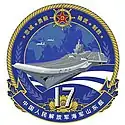Chinese aircraft carrier Shandong
Shandong (17; Chinese: 山东舰; pinyin: Shāndōng Jiàn) is a first-generation Chinese aircraft carrier that was launched on 26 April 2017 for the People's Liberation Army Navy (PLAN) of the People's Republic of China (PRC).[6] It is the country's second aircraft carrier after the completion of Liaoning, and the first built domestically. Shandong was initially designated as a Type 001A air carrier during development but was finalized as Type 002 at commissioning.[7]
 Shandong moored at Dalian in 2019 prior to commissioning | |
| History | |
|---|---|
| Name: |
|
| Namesake: | Shandong Province |
| Builder: | Dalian Shipbuilding Industry |
| Laid down: | March 2015 |
| Launched: | 26 April 2017 |
| Completed: | 25 April 2018 |
| Commissioned: | 17 December 2019 |
| Status: | In active service |
| Badge: |
 |
| General characteristics (as designed) | |
| Class and type: | Type 002 (variant of Kuznetsov-class aircraft carrier) |
| Displacement: | Standard Load 55,000 tons, Full Load 66,000 to 70,000 tons [1][2][3] |
| Length: | 315 m (1,033 ft)[4] |
| Beam: | 75 metres (246 ft)[4] |
| Propulsion: | Conventional steam turbines, 4 shafts |
| Speed: | 31 knots (36 mph; 57 km/h)[4] |
| Sensors and processing systems: |
|
| Armament: |
|
| Aircraft carried: |
|
History
Construction

Shandong was constructed by the Dalian Shipbuilding Industry, part of the China Shipbuilding Industry Corporation, in Dalian, Liaoning province, China.[8] According to the state media service Xinhua, manufacture began in November 2013 and laid down the keel for its hull in a drydock beginning in March 2015.[8]
The Chinese government did not publicly confirm the ship's existence until construction was well underway. Satellite imagery for the defense analysis industry showed the aircraft carrier in the early stages of hull assembly by March 2015. Public photos of a hull with military characteristics at the Dalian shipyard surfaced on the internet the next month.[9][10] In October 2015, the first definitive signs of the vessel's role appeared when construction of a hangar deck began on the hull.[10] In December 2015, a Chinese defense ministry spokesman confirmed that the ship was an aircraft carrier, stating that the design and construction work was under way.[11]
In May 2016, the ski jump takeoff ramp was noted to be close to installation.[12] The ship's island superstructure was fabricated in two parts: the nine-deck forward half, containing the bridge and main mast, was installed by September of that year; the aft half, with the funnel and air intakes, was installed in the weeks that followed.[13][14] By the end of 2016, the ship was substantially structurally complete.[15]
Out-fitting
Following the launch, the carrier was fitted-out and underwent early tests of the propulsion system.[16] The dockside system trials began after the out-fitting was completed in November 2017.[17]
At the time of its launch, the ship was not expected to be delivered to PLAN until 2020; however, successful early tests put the project ahead of schedule and media reports indicated that it could enter the navy fleet in 2019.[16] While its predecessor Liaoning has been used largely as a training ship since it entered active service in 2012, the Type 002 is expected to be used in regular military operational service.[18]
Sea trials
The first sea trial of the carrier took place in May 2018 in the Bohai Sea.[19] This was followed by eight more trials through November 2019 for a total of about 19 months before the carrier was commissioned. The ninth and final sea trial, which commenced from 14 November 2019, was conducted simultaneously with a training exercise in South China Sea. The dates and durations of the sea trials are as follow:[20]
- First sea trial: 13–18 May 2018
- Second sea trial: 26 August – 4 September 2018
- Third sea trial: 28 October – 6 November 2018
- Fourth sea trial: 27 December 2018 – 8 January 2019
- Fifth sea trial: 27 February – 4 March 2019
- Sixth sea trial: 25–31 May 2019
- Seventh sea trial: 1–4 August 2019 and 6–22 August 2019
- Eighth sea trial: 15–20 October 2019
- Ninth sea trial: from 14 November 2019 (end date unknown)
The arresting gear was installed on 11 September 2018 after the second sea trial. This was immediately followed by flight tests of the J–15, Z–18 and Z–9 on 14 September 2018. J–15D, the Electronic Warfare (EW) version of the aircraft, was also spotted on deck on 9 October 2018.[20]
Commissioning
The carrier was commissioned on 17 December 2019 at Sanya, Hainan by Central Military Commission chairman Xi Jinping and was officially named Shandong.[21] After commissioning, according to Chinese media Shandong reached in October 2020 Initial Operational Capability (IOC) or basic standards for deployment, which its predecessor Liaoning only attained six years after commissioning, in 2018.[21][22] Lai Yijun, a senior captain who previously commanded PLAN frigate Lianyungang (连云港号护卫舰) was the captain of Shandong at commissioning.[23]
Design
The aircraft carrier's design is largely based on China's first carrier Liaoning, which was itself built from the partially-complete hull of the Soviet Kuznetsov-class aircraft carrier Varyag.[13] It retains the ski jump takeoff, which limits its air wing to helicopters and Shenyang J-15 fighter jets of the People's Liberation Army Navy Air Force,[12][15] and the ship is powered by conventional oil-fired boilers driving eight steam turbines derived from the Soviet-designed examples installed on Liaoning.[13][24] It measures about 315 metres (1,033 ft) long, with a displacement of about 55,000 tonnes (66,000 - 70,000 loaded).[25][18]
The Shandong is a significant improvement over the Soviet built Liaoning. For example, the Shandong carrier's ski jump has an angle of 12.0° instead of the 14.0° on the Liaoning. This is an angle ideal for launching the Shenyang J-15 fighter. Together with the enlarged hangar, the island which has been made smaller by 10%, and extended on sponsons in the aft-starboard quarter, space has been freed up allowing for up to eight more aircraft and helicopters to be carried. The island includes a second glazed deck which permits the bridge and flight control areas to be separate creating greater operational efficiency. It also features a faceted upper area of four Active Electronically Scanned Arrays (AESAs) for the improved Type 346A S-band radar (Type 346 radar).[26]
Shandong, like its predecessor, uses the simpler "short take-off but arrested recovery" (STOBAR) launch and recovery system. Future Chinese carriers, such as the Type 003 aircraft carrier, are planned to use an Electromagnetic Aircraft Launch System (EMALS) that allows the launch of heavier and more advanced aircraft such as the Shenyang J-31 or the Chengdu J-20.[27][28]
See also
References
- "Liaoning - Specifications". GlobalSecurity.org. Retrieved 23 December 2019.
- "What we know so far about China's second aircraft carrier". chinapower.csis.org. Retrieved 23 December 2019.
- "CNS Shandong (17) (Type 001A) Conventionally-Powered Aircraft Carrier".
- Chan, Minnie (12 April 2017). "10 things you should know about China's first home-built aircraft carrier". South China Morning Post. Archived from the original on 27 February 2018. Retrieved 29 April 2017.
- Roblin, Sebastien (22 December 2019). "China's New Aircraft Carrier Shandong: 5 Things You Need to Know". The National Interest.
- Buckley, Chris (25 April 2017). "China, Sending a Signal, Launches a Home-Built Aircraft Carrier". The New York Times. ISSN 0362-4331. Retrieved 23 December 2019.
- Ben Westcott. "China's first domestically-built aircraft carrier officially enters service". CNN. Retrieved 24 December 2019.
- "China launches second aircraft carrier". Xinhua. 26 April 2017. Archived from the original on 26 April 2017. Retrieved 26 April 2017.
- "China may be building first indigenous carrier". Jane's Defence Weekly. IHS. 27 September 2015. Archived from the original on 30 September 2015. Retrieved 26 April 2017.
- "China's First Homemade Carrier Moves Forward". Popular Science. 27 October 2015. Archived from the original on 2 May 2017. Retrieved 26 April 2017.
- "China Begins Building Second Aircraft Carrier". The Wall Street Journal. 31 December 2015. Archived from the original on 27 April 2017. Retrieved 26 April 2017.
- "China's New Carrier Gets A Ski Ramp". Popular Science. 20 May 2016. Archived from the original on 2 May 2017. Retrieved 26 April 2017.
- "Further progress made on China's Type 001A carrier". IHS Jane's Defence Weekly. 26 September 2016. Archived from the original on 1 November 2016. Retrieved 26 April 2017.
- "China Adds An Island Tower To Its Aircraft Carrier". Popular Science. 6 October 2016. Archived from the original on 4 May 2017. Retrieved 26 April 2017.
- "Analysis: Chinese aircraft carrier program progressing substantially into the new year". Defense News. 31 January 2017. Retrieved 26 April 2017.
- "China's first home-grown aircraft carrier could join the navy ahead of schedule". South China Morning Post. 4 August 2017. Archived from the original on 30 April 2018. Retrieved 29 April 2018.
- "China's first domestically built aircraft carrier completes outfitting". China Daily. 23 November 2017. Archived from the original on 23 April 2018. Retrieved 29 April 2018.
- "China Launches First Home-Built Aircraft Carrier, Boosting Naval Power". The Wall Street Journal. 26 April 2017. Retrieved 26 April 2017.
- LaGrone, Sam (22 May 2018). "First Chinese-built Carrier Returns from Successful Sea Trials". USNI News. Retrieved 18 June 2019.
- "What do we know so far about China's second aircraft carrier?". ChinaPower Project. 22 April 2017. Retrieved 24 December 2019.
- "Smaller fighter jet force expected for China's new aircraft carrier". South China Morning Post. 20 December 2019. Retrieved 23 December 2019.
- https://www.defenseworld.net/news/28188/Chinese_Navy_Ready_for_Dual_Aircraft_Carrier_Missions#.X7FfPYuP7IV
- "First made-in-China aircraft carrier Shandong officially enters service". South China Morning Post. 17 December 2019. Retrieved 24 December 2019.
- "China's first home-grown Type 001A aircraft carrier begins maiden sea trial". South China Morning Post. 23 April 2018. Archived from the original on 29 April 2018. Retrieved 30 December 2018.
- "China, Sending a Signal, Launches a Home-Built Aircraft Carrier". The New York Times. 25 April 2017. Archived from the original on 8 March 2018. Retrieved 26 April 2017.
- "A look at China's new Type 002 'Shandong' aircraft carrier". UK Defence Journal. 10 January 2020. Retrieved 2 August 2020.
- China's making major progress with its aircraft carrier tech Archived 25 April 2018 at the Wayback Machine. Popular Science. 16 August 2017.
- Dominguez, Gabriel (7 December 2017). "Future Chinese carriers to deploy J-20, J-31 stealth fighters, says report". Jane's Information Group. Archived from the original on 8 December 2017.